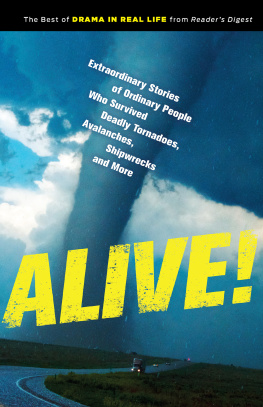A READERS DIGEST BOOK
Copyright 2016 The Readers Digest Association, Inc.
All rights reserved. Unauthorized reproduction, in any manner, is prohibited.
Readers Digest is a registered trademark of The Readers Digest Association, Inc.
Photographers: Ruth Jenkinson, Lizzie Orme
Picture credits: Sebastian Kaulitzki/Alamy
Illustrator: Tom Connell
The Readers Digest Quintessential Guide to Handling Emergencies contains material first published in What to Do in an Emergency.
Library of Congress Cataloging-in-Publication Data
Readers digest quintessential guide to handling emergencies / by the Editors at Readers Digest.
pages cm. -- (Rd quintessential guides)
Includes index.
ISBN 978-1-62145-250-8 (spiral bound) -- ISBN 978-1-62145-251-5 (epub) 1. Home accidents--Prevention--Handbooks, manuals, etc. 2. First aid in illness and injury--Handbooks, manuals, etc. 3. Emergencies--Handbooks, manuals, etc. I. Readers Digest Association
TX150.R43 2015
363.1372--dc23
We are committed to both the quality of our products and the service we provide to our customers. We value your comments, so please feel free to contact us.
The Readers Digest Association, Inc.
Adult Trade Publishing
44 South Broadway
White Plains, NY 10601
For more Readers Digest products and information, visit our website:
www.rd.com (in the United States)
www.readersdigest.ca (in Canada)
HOW TO USE THIS BOOK
The Readers Digest Quintessential Guide to Handling Emergencies assumes that you may have to deal with a difficult and dangerous situation without professional help. The instructions should enable you to minimize injury and damage and get effective help and support as swiftly as possible.
This book has been designed to help you cope with a range of possible situations, some that all of us may face one day; others much rarer. The first three chapters deal with problems arising in your home, including general situations, fires, and water damage. The next chapter focuses on medical emergencies, including key life-saving techniques and critical signs. The final chapter concentrates on first aid.
Important: The information in this book has been carefully researched and all efforts have been made to ensure safety and accuracy. The Readers Digest Association, Inc., does not assume any responsibility for any injuries suffered or losses incurred as a result of following the instructions in this book. Before taking any action based on information in this book, study the information carefully and make sure you understand it fully. Observe any warnings and take care notices.
WARNING
Medication: Always follow the package instructions when taking medication and be aware of any contraindications. If youre unsure, consult a pharmacist or your GP for advice.
Emergency calls: It is illegal to use a handheld phone while driving. You must try to pull over to a safe spot before making a phone call, even in an emergency.
CONTENTS


GENERAL
ISSUES
Solving problems in and around the house.
CARBON MONOXIDE BUILD-UP

Carbon monoxide (CO) is produced when gas is not properly burned in a faulty or poorly maintained gas appliance. It has no smell, so you cannot detect it, though you may show signs of a number of physical symptoms if exposed to the gas. If allowed to build up, it can lead to serious poisoning and, ultimately, death.
You cannot see, taste, or smell carbon monoxide, but it can kill you without warning in a matter of hours.
The physical symptoms of CO poisoning are tiredness, drowsiness, headaches, nausea, and pains in the chest and stomach, all of which can be confused with the symptoms of the flu or normal tiredness.
An appliance may produce carbon monoxide if it is poorly installed or maintained, if there is a lack of fresh air for safe combustion of the gas, or if there is a blocked chimney.
You are at particular risk if you sleep in a room with a gas appliance such as a gas fireplace or water heater, which is left on at night and does not have a fresh air intake. A fresh air intake allows the products of combustion of the gas to be taken outside and fresh air for combustion to be drawn in.
1. Disperse gas. Open all doors and windows to allow any gas to disperse.
2. Vacate area. Tell the rest of the family and move them out of harms way. Notify your neighbors.
3. Shut off gas supply. If possible, turn off the faulty appliance or turn the gas off at the main gas tap. Phone your gas utility immediately.
4. Suspect symptoms. If you are suffering from physical symptoms only when at home, visit your doctor or local hospital and tell them you suspect carbon monoxide poisoning.
Carbon monoxide alarms
Carbon monoxide alarms warn of a leak. Since CO is colorless, tasteless, and odorless (unlike smoke from a fire), detection in a home environment is impossible without such a warning device. They can be hardwired or battery-operated, carbon monoxide only or combined CO/smoke alarms. The one shown here is a battery-operated carbon-monoxide-only detector.
Battery-operated detectors need little or no installation. Some hardwired detectors plug into an outlet, whereas others are wired into a circuit and need to be installed by an electrician. Refer to the manufacturers instructions for the optimum location for any detector that you buy.

CHIMNEY COLLAPSES

A chimney collapsing isfortunatelya rare occurrence, but it can cause serious damage to your own and other properties and potentially to people passing nearby. There is nothing you can do if a natural disaster causes the collapse, but you can take steps to ensure that your chimney is not a danger.
Chimneys can collapse in a serious storm. At least some of those that collapsed would have been weakened beforehand by other causes.
A chimney fire can weaken chimney stacks because it causes the chimney to expand, which can crack the masonry.
Cracking can also occur because of failed mortar pointing or failed chimney flashing, allowing water to get into the brickwork. If the water freezes, it expands, leading to cracking.
A satellite dish (or large TV antenna) can cause structural damage to a chimney, especially if it is mounted on a long pole and exposed to strong winds.
If the flue liner in a chimney is damaged or missing, combustion gases will destroy the mortar joints, causing the chimney to lean and eventually collapse. Make sure your chimney has a stainless steel liner or a cast-in-place cement liner.
1. Get help. Call emergency services. The fire department can help to make the property safe and an ambulance will be needed if anyone has been injured.
2. Give first aid. Do the best you can to help anyone who has been injured. If you are not sure what to do, ask the 911 dispatcher when you call them.














